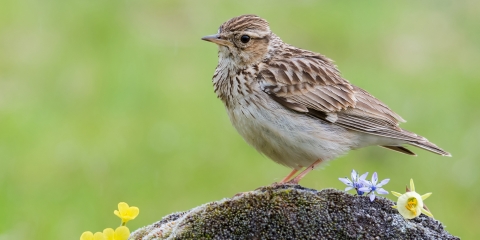Bird Bioacoustics Surveying Of Nightjar, Woodlark & Dartford Warbler For Thames Basin Heaths SPA

Baker Consultants has been shortlisted for a CIEEM award for Best Practice Innovation, due to be announced in January 2021 (due to Covid delays), for innovative bird bioacoustics surveying work in a Special Protection Area in Thames Basin Heaths.
In 2018, Baker Consultants recorded bird song at 44 sites within the Thames Basin Heaths and Wealden Heaths SPAs using automated recording units. These sites are internationally designated for their breeding populations of European nightjar, woodlark and Dartford Warbler.
Funded by Natural England, who has been coordinating annual surveys of the Thames Basin Heaths SPA bird species since 2003, the research was carried out by Baker Consultant’s Technical Director Carlos Abraham.
Natural England selected Baker Consultants for the work due to previous pioneering work published by Baker Consultants (link to Zwart et al etc ) on the use of bioacoustics for surveying nightjar and other bird species.
Jessica James of Natural England commented, “The TBH team was aware of the pioneering work that Baker Consultants had published on the use of bioacoustics for surveying nightjar[1] and other bird species. Following a conversation with Andrew Baker, Marc Turner (NE’s senior planning advisor for TBH) asked Baker Consultants to consider how the techniques could be applied to monitoring the interest features of the Thames Basin Heaths SPA. Baker Consultants responded to our request by offering a detailed research proposal which was comprehensively supported with reference to the peer-reviewed literature.”
This was the first project of its type in Europe, and one of only a handful of similar studies that have been undertaken globally. The data gathered from bioacoustic surveys was assessed within an ‘occupancy modelling’ framework. This is a relatively new statistical analysis method that allows population density (‘occupancy’) to be calculated, whilst also taking into account the accuracy of the survey method (‘detectability’).
The study is also the first in the UK to undertake a large-scale survey for multiple bird species using automated recorders. It therefore expands the geographic scope of case studies for these methods, and applies them in a new habitat, beyond the American forested ecosystems in which most previous studies have been located.
One of the benefits of the approach taken in this study is its ease of replication. The automated recorders used were off-the-shelf commercial units (Wildlife Acoustics SongMeters), the software for call analysis (Kaleidoscope Pro) is also widely available and currently used by a number of organisations. Statistical analysis was conducted in open-source R and the code scripts will shortly be made publicly available by Baker Consultants in a permanent data repository (Mendeley Data). As such, the project could be repeated by others on different sites, and with different species, as appropriate to their own project needs.
In addition, the project has also prompted the development of a draft protocol for bird bioacoustics, published in CIEEMs In Practice, and has been included as a case study in a CIEEM webinar and training workshop on bioacoustics, and delivered at talks for the BES and UK Acoustics Network. Further training, building on the outputs of the project, has also taken place on behalf of PR Statistics, Natural England and Wildlabs.net. A scientific paper based on the study has recently been published in Ecological Indicators.
Jessica James said of the results of the project, “Natural England was very impressed with the quality of the work completed by Baker Consultants. This was a relatively small demonstration project with limited funding. However, the outputs were considerable and exceeded our expectations in terms of the breadth of the work and the possibilities for applying this technique in the future to monitor not only the target species of the Thames Basin Heaths but also other target species on other sites and habitats. We feel that the work made a significant contribution to the development of best practice for monitoring ecological change and will lead to positive outcomes for wider nature conservation.”
On national and international scales, there is a critical need for effective, replicable and long-term monitoring of threatened wildlife and so at Baker Consultants we were excited about the successful outcomes of this project. New technology provides the opportunity for innovative fieldwork and assessment methods, enabling potential benefits to the monitoring of notable species and management of important sites. Bioacoustic monitoring has transformed the understanding of bat and cetacean ecology in recent years, but so far, has been little used for other taxa – despite a rapidly increasing scientific evidence-base.
Most importantly, our study demonstrates that the innovative methods used offer a practical alternative to ‘traditional’ bird monitoring methods, offering more effective data capture through longer-term deployment, consistent coverage between sites, avoidance of observer biases and enabling the use of better statistical methods.
If you have surveying or species monitoring needs, then please get in touch with us via our contact form on the website, or you can call us on +44 (0)1629 593958 or email us on info@bakerconsultants.co.uk.
[1] (Zwart, M.C., Baker, A., McGowan, P.J.K., & Whittingham, M.J (2014) The Use of Automated Bioacoustic Recorders to Replace Human Wildlife Surveys: An Example Using Nightjars PLoS One 9(7).
